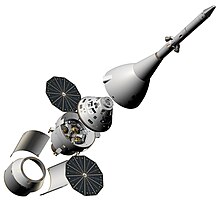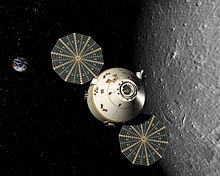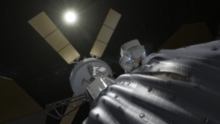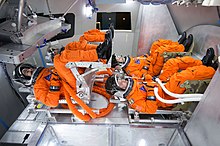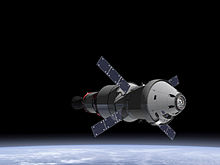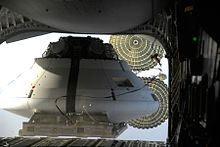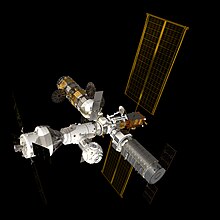
Artist's rendering of the Orion spacecraft
| |
| Manufacturer | Lockheed Martin Airbus |
|---|---|
| Country of origin | United States of America |
| Operator | NASA |
| Applications | Beyond LEO exploration |
| Specifications | |
| Spacecraft type | Space capsule |
| Design life | 21.1 days |
| Launch mass | Capsule: 10,387 kg (22,899 lb) Service module: 15,461 kg (34,086 lb) Total: 25,848 kg (56,985 lb) |
| Crew capacity | 2–6 |
| Dimensions | 3.3 × 5 m (11 × 16 ft) |
| Volume | Pressurized: 19.56 m3 (691 cu ft) Habitable: 8.95 m3 (316 cu ft) |
| Production | |
| Status | In production |
| Built | 3 |
| Launched | 1 |
| First launch | Exploration Flight Test 1 December 5, 2014 |
| Related spacecraft | |
| Derived from | Crew Exploration Vehicle • ATV |
The Orion Multi-Purpose Crew Vehicle (Orion MPCV) is an American-European interplanetary spacecraft intended to carry a crew of four astronauts to destinations at or beyond low Earth orbit (LEO). Currently under development by the National Aeronautics and Space Administration (NASA) and the European Space Agency (ESA) for launch on the Space Launch System, Orion is intended to facilitate human exploration of the Moon, asteroids and of Mars and to retrieve crew or supplies from the International Space Station if needed.
The Orion MPCV was announced by NASA on May 24, 2011, and is currently under development. Its design is based on the Orion Crew Exploration Vehicle from the cancelled Constellation program. It has two main modules. The Orion command module is being built by Lockheed Martin at the Michoud Assembly Facility in New Orleans. The Orion service module, provided by the European Space Agency, is being built by Airbus Defence and Space.
The MPCV's first test flight (uncrewed), known as Exploration Flight Test 1 (EFT-1), was launched atop a Delta IV Heavy rocket on December 5, 2014, on a flight lasting 4 hours and 24 minutes, landing at its target in the Pacific Ocean at 10:29 Central (delayed from the prior day due to technical and weather problems). The first mission to carry astronauts is not expected to take place until 2023 at the earliest, although NASA officials have said that their staff is working toward an "aggressive internal goal" of 2021. However, a July 2016 Government Accountability Office report cast doubt on even the 2023 launch date, suggesting it may slip up to six months. The report gave only a 40% confidence in the 2021 launch date, and suggested the aggressive goal may be counterproductive to the program.
History
Funding history and planning
For
fiscal years 2006 through 2018, the Orion program had expended funding
totaling $15,983 million in nominal dollars. This is equivalent to
$18,138 million adjusting to 2018 dollars using the NASA New Start
Inflation Indices.
| Fiscal year | Funding (USD, millions) |
Line item name |
|---|---|---|
| 2006 | 839.2 | CEV |
| 2007 | 714.5 | CEV |
| 2008 | 1,174.1 | CEV |
| 2009 | 1,747.9 | CEV |
| 2010 | 1,640 | CEV |
| 2011 | 1,196.0 | MPCV |
| 2012 | 1,200 | Orion MPCV |
| 2013 | 1,138 | Orion MPCV |
| 2014 | 1,197 | Orion Program |
| 2015 | 1,190.2 | Orion Program |
| 2016 | 1,270 | Orion Program |
| 2017 | 1,350.0 | Orion |
| 2018 | 1,350.0 | Orion |
| 2006-2018 | Total $15,983 |
|
Excluded from the prior Orion costs are:
- Costs "for production, operations, or sustainment of additional crew capsules, despite plans to use and possibly enhance this capsule after 2021"
- Costs of the first service module and spare parts to be provided by the European Space Agency for the test flight of Orion in 2020 (about $1 billion)
- Costs to assemble, integrate, prepare and launch the Orion and its launcher (funded under the NASA Ground Operations Project, currently about $400M per year)
- Costs of the launcher, the SLS, for the Orion spacecraft
For 2019 to 2023, NASA "notional"
yearly budgets for Orion range from $1.1 to $1.2 billion. As of late
2015, the Orion program has a 70% confidence level for its “first Orion
mission with astronauts by 2023” according to the Associate
Administrator for NASA, Robert Lightfoot.
There are no NASA estimates for the Orion program recurring
yearly costs once operational, for a certain flight rate per year, or
for the resulting average costs per flight. Bill Hill, NASA manager of
exploration systems development has indicated “My top number for Orion,
SLS, and the ground systems that support it is $2 billion or less”
(annually).
NASA associate administrator William H. Gerstenmaier has indicated,
“[per mission] costs must be derived from the data and are not directly
available. This was done by design to lower NASA's expenditures.”
Orion Crew Exploration Vehicle (CEV)
Orion CEV design as of 2009.
On January 14, 2004, U.S. President George W. Bush announced the Crew Exploration Vehicle (CEV) as part of the Vision for Space Exploration. The CEV was partly a reaction to the Space Shuttle Columbia accident, the subsequent findings and report by the Columbia Accident Investigation Board (CAIB), and the White House's review of the American space program. The CEV effectively replaced the conceptual Orbital Space Plane (OSP), which was proposed after the cancellation of the Lockheed Martin X-33 program to produce a replacement for the Space Shuttle. As the Vision for Space Exploration was developed into the Constellation program under NASA administrator Sean O'Keefe, the Crew Exploration Vehicle was renamed the Orion Crew Exploration Vehicle, after the stellar constellation of the same name.
Constellation proposed using the Orion CEV in both crew and cargo variants to support the International Space Station
and as a crew vehicle for a return to the Moon. The Apollo-like design
included a service module for life support and propulsion and the
crew/command module was originally intended to land on solid ground on
the US west coast using airbags, but later changed to ocean splashdown. The Orion CEV weighs about 23 tonnes, less than the 30 tonne Apollo command and service module. The crew module would weigh about 8.9 tonnes, greater than the equivalent Apollo command module
at 5.8 tonnes. With a diameter of 5 metres as opposed to 3.9 metres,
the Orion CEV would provide 2.5 times greater volume as compared to the
Apollo CM. The service module was originally planned to use liquid methane (LCH4) as its fuel, but switched to hypergolic propellants due to the infancy of oxygen/methane-powered rocket technologies and the goal of launching the Orion CEV by 2012.
The Orion CEV design consisted of two main parts: a conical crew
module (CM) and a cylindrical service module (SM) holding the
spacecraft's propulsion system and expendable supplies. Both were based
substantially on the Apollo command and service modules flown between 1967 and 1975.
The Orion CEV was to be launched on the Ares I rocket to low Earth orbit, where it would rendezvous with the Altair lunar surface access module (LSAM) launched on a heavy-lift Ares V launch vehicle for lunar missions.
Cancellation of Constellation program
Artist's conception of the Orion spacecraft as then designed in lunar orbit.
On May 7, 2009, the Obama administration enlisted the Augustine Commission to perform a full independent review of the ongoing NASA space exploration program. The commission found the then current Constellation Program
to be woefully under-budgeted, behind schedule by four years or more in
several essential components, with significant cost overruns, and
unlikely to be capable of meeting any of its scheduled goals under its
current budget.
As a consequence, the commission recommended a significant
re-allocation of goals and resources. As one of the many outcomes based
on these recommendations, on October 11, 2010, the Constellation
program was cancelled, ending development of the Altair, Ares I, and
Ares V. The Orion Crew Exploration Vehicle survived the cancellation and
was renamed the Multi-Purpose Crew Vehicle (MPCV), to be launched on
the Space Launch System.
Orion Multi-Purpose Crew Vehicle (MPCV)
Through
the program restructuring from Constellation to Post Constellation, the
Orion development program moved from the development of three different
versions of the Orion capsule, each for a different task, to the development of a single version capable of performing multiple tasks.
On October 30, 2014, the somewhat redesigned Multi-Purpose spacecraft
completed its first flight readiness review (FRR), allowing the vehicle
to be integrated with the Delta IV rocket and readied for launch. On
December 5, 2014 it was successfully launched into space and retrieved
at sea after splashdown on the Exploration Flight Test 1 (EFT-1), marking NASA's re-entry into the business of designing and producing new crewed spacecraft.
Asteroid Redirect Mission
Artist's concept of an astronaut on an EVA taking samples from a captured asteroid; Orion in the background.
This mission would have placed an asteroid in lunar orbit, rather than sending astronauts to an asteroid in deep space. It was a part of the FY2014 budget request. Originally planned for 2017, then 2020, and then for December 2021, the mission was given its notice of defunding in April 2017. The launch vehicle would have been either a Delta IV Heavy, SLS or Falcon Heavy. The boulder would have arrived in lunar orbit by late 2025, where it was to be further analyzed both by robotic probes and by a future crewed mission called ARCM (Asteroid Redirect Crewed Mission).
The development of advanced solar electric propulsion technology originally meant for this mission continues for its potential application on the proposed Lunar Orbital Platform-Gateway.
Design
Interactive 3D models of Orion, with the spacecraft fully integrated on the left and in exploded view on the right.
The Orion MPCV takes basic design elements from the Apollo command module
that took astronauts to the Moon, but its technology and capability are
more advanced. It is designed to support long-duration deep space
missions, with up to 21 days active crew time plus 6 months quiescent. During the quiescent period crew life support would be provided by another module such as a Deep Space Habitat.
The spacecraft's life support, propulsion, thermal protection, and
avionics systems are designed to be upgradeable as new technologies
become available.
The MPCV spacecraft includes both crew and service modules, and a spacecraft adaptor.
The MPCV's crew module is larger than Apollo's and can support
more crew members for short or long-duration missions. The service
module fuels and propels the spacecraft as well as storing oxygen and
water for astronauts. The service module's structure is also being
designed to provide locations to mount scientific experiments and cargo.
Crew module (CM)
Interior of the Orion mock-up in October 2014.
Testing of Orion's parachute system.
The Orion crew module (CM) is the reusable transportation capsule
that provides a habitat for the crew, provides storage for consumables
and research instruments, and serves as the docking port for crew
transfers. The crew module is the only part of the MPCV that returns to Earth after each mission and is a 57.5° frustum shape, similar to that of the Apollo command module. As projected, the CM will be 5.02 meters (16 ft 6 in) in diameter and 3.3 meters (10 ft 10 in) in length, with a mass of about 8.5 metric tons (19,000 lb). It was manufactured by the Lockheed Martin Corporation. It will have more than 50% more volume than the Apollo capsule, which had an interior volume of 5.9 m3 (210 cu ft), and will carry four to six astronauts. After extensive study, NASA has selected the Avcoat ablator system for the Orion crew module. Avcoat, which is composed of silica fibers with a resin in a honeycomb made of fiberglass and phenolic resin, was formerly used on the Apollo missions and on select areas of the space shuttle for early flights.
Orion's CM will use advanced technologies, including:
- "Glass cockpit" digital control systems derived from those of the Boeing 787 Dreamliner.
- An "autodock" feature, like those of Russian Progress spacecraft, the European Automated Transfer Vehicle, and the SpaceX Dragon 2, with provision for the flight crew to take over in an emergency. Prior American spacecraft (Gemini, Apollo, and Space Shuttle) have all needed manual piloting for docking.
- Improved waste-management facilities, with a miniature camping-style toilet and the unisex "relief tube" used on the space shuttle (whose system was based on that used on Skylab) and the International Space Station (based on the Soyuz, Salyut, and Mir systems). This eliminates the use of the much-hated plastic "Apollo bags" used by the Apollo crews.
- A nitrogen/oxygen (N
2/O
2) mixed atmosphere at either sea level (101.3 kPa or 14.69 psi) or reduced (55.2 to 70.3 kPa or 8.01 to 10.20 psi) pressure. - Far more advanced computers than on prior crew vehicles.
The CM will be built of the aluminium-lithium alloy used on the Space Shuttle external tank, and the Delta IV and Atlas V rockets. The CM will be covered in the same Nomex felt-like thermal protection blankets used on parts on the shuttle
not subject to critical heating, such as the payload bay doors. The
reusable recovery parachutes will be based on the parachutes used on
both the Apollo spacecraft and the Space Shuttle Solid Rocket Boosters, and will also use Nomex cloth for construction. Water landings will be the exclusive means of recovery for the Orion CM.
To allow Orion to mate with other vehicles, it will be equipped with the NASA Docking System, which is somewhat similar to the APAS-95 docking mechanism used on the Shuttle fleet. The spacecraft will employ a Launch Escape System (LES) like that used in Mercury and Apollo, along with an Apollo-derived "Boost Protective Cover" (made of fiberglass), to protect the Orion CM from aerodynamic and impact stresses during the first 2 1⁄2 minutes of ascent. Its designers claim that the MPCV is designed to be 10 times safer during ascent and reentry than the Space Shuttle.
The CM is designed to be refurbished and reused. In addition, all of
the Orion's component parts have been designed to be as generic as
possible, so that between the craft's first test flight in 2014 and its
projected Mars voyage in the 2030s, the spacecraft can be upgraded as
new technologies become available.
ATV-based European service module (ESM)
Artist's concept of an Orion spacecraft including the ATV-derived service module with a propulsion stage attached at the back
In May 2011 the ESA director general announced a possible collaboration with NASA to work on a successor to the ATV (Automated Transfer Vehicle). On June 21, 2012, Airbus Defence and Space
announced that they had been awarded two separate studies, each worth
€6.5 million, to evaluate the possibilities of using technology and
experience gained from ATV and Columbus
related work for future missions. The first looked into the possible
construction of a service module which would be used in tandem with the
Orion capsule. The second examined the possible production of a versatile multi purpose orbital vehicle.
On November 21, 2012, the ESA decided to develop an ATV-derived service module for the Orion MPCV. The service module is being manufactured by Airbus Defence and Space in Bremen, Germany. NASA announced on January 16, 2013 that the ESA service module will first fly on Exploration Mission 1, the debut launch of the Space Launch System.
Testing of the European service module began in February 2016, at the Space Power Facility.
On 16 February 2017 a €200m contract was signed between Airbus and the European Space Agency for the production of a second European service module for use on the first crewed Orion flight, called Exploration Mission-2 (EM-2).
Launch Abort System (LAS)
In the event of an emergency on the launch pad or during ascent, a launch escape system called the Launch Abort System (LAS) will separate the crew module from the launch vehicle using a solid rocket-powered launch abort motor (AM), which will produce more thrust (though for a much shorter duration) than the Atlas 109-D booster that launched astronaut John Glenn into orbit in 1962.
There are two other propulsion systems in the LAS stack: the attitude
control motor (ACM) and the jettison motor (JM). The ACM is a thruster
system on the escape tower used to position and orient the capsule. The jettison motor is a solid rocket system used to separate the LAS from the crew capsule. On July 10, 2007, Orbital Sciences, the prime contractor for the LAS, awarded Alliant Techsystems (ATK) a $62.5 million sub-contract to, "design, develop, produce, test and deliver the launch abort motor." ATK, which had the prime contract for the first stage of the Ares I rocket, intended to use a "reverse flow" design for the motor. On July 9, 2008, NASA announced that ATK had completed a vertical test stand at a facility in Promontory, Utah to test launch abort motors for the Orion spacecraft. Another long-time space motor contractor, Aerojet, was awarded the jettison motor design and development contract for the LAS. As of September 2008, Aerojet has, along with team members Orbital Sciences, Lockheed Martin and NASA,
successfully demonstrated two full-scale test firings of the jettison
motor. This motor is important to every flight in that it functions to
pull the LAS tower away from the vehicle after a successful launch. The
motor also functions in the same manner for an abort scenario.
Existing craft mockups and testing
- Space Vehicle Mockup Facility (SVMF) in Johnson Space Center, includes a full-scale Orion capsule mock-up for astronaut training.
- Exploration Flight Test 1 (EFT-1) Orion (originally designated OFT-1), constructed at Michoud Assembly Facility, was delivered by Lockheed Martin to the Kennedy Space Center on July 2, 2012 and launched and recovered on December 5, 2014.
- The Boilerplate Test Article (BTA) underwent splashdown testing at the Hydro Impact Basin of NASA's Langley Research Center. This same test article has been modified to support Orion Recovery Testing in the Stationary and Underway recovery tests. The BTA contains over 150 sensors to gather data on its test drops. Testing of the 18,000 pound mockup ran from July 2011 to January 6, 2012.
- The Ground Test Article (GTA) stack, located at Lockheed Martin in Denver, is undergoing vibration testing. It is made up by the Orion Ground Test Vehicle (GTV) combined with its Launch Abort System (LAS). Further testing will see the addition of service module simulator panels and Thermal Protection System (TPS) to the GTA stack.
The Orion Drop Test Article during a test on February 29, 2012
- The Drop Test Article (DTA), also known as the Drop Test Vehicle (DTV) is undergoing test drops at the US Army's Yuma Proving Ground in Arizona. The mock Orion parachute compartment is dropped from an altitude of 25,000 feet from a C-130. Testing began in 2007. Drogue chutes deploy around 20,000 and 15,000 feet. Testing of the reefing staged parachutes includes partial failure instances including partial opening and complete failure of one of the three main parachutes. With only two chutes deployed the DTA lands at 33 feet per second, the maximum touchdown speed for Orion's design. Other related test vehicles include the now-defunct Orion Parachute Test Vehicle (PTV) and its replacement the Generation II Parachute Test Vehicle (PTV2). The drop test program has had several failures in 2007, 2008, and 2010. The new PTV was successfully tested February 29, 2012 deploying from a C-17. Ten drag chutes will drag the mockup's pallet from the aircraft for the drop at 25,000 feet. The landing parachute set of eight is known as the Capsule Parachute Assembly System (CPAS). The test examined air flow disturbance behind the mimicked full size vehicle and its effects on the parachute system. The PTV landed on the desert floor at 17 mph (7.6 m/s). A third test vehicle, the PCDTV3, was successfully tested in a drop on April 17, 2012. "The test examined how Orion's wake, the disturbance of the air flow behind the vehicle, would affect the performance of the parachute system."
Environmental testing
NASA performed environmental testing of Orion from 2007 to 2011 at the Glenn Research Center Plum Brook Station in Sandusky, Ohio. The Center's Space Power Facility is the world's largest thermal vacuum chamber.
Launch abort system (LAS) testing
ATK
Aerospace successfully completed the first Orion Launch Abort System
(LAS) test on November 20, 2008. The LAS motor could provide 500,000 lbf (2,200 kN)
of thrust in case an emergency situation should arise on the launch pad
or during the first 300,000 feet (91 km) of the rocket's climb to
orbit. The 2008 test firing of the LAS was the first time a motor with
reverse flow propulsion technology of this scale had ever been tested.
On March 2, 2009, a full size, full weight command module mockup
(pathfinder) began its journey from the Langley Research Center to the
White Sands Missile Range, New Mexico, for at-gantry launch vehicle
assembly training and for LAS testing.
On May 10, 2010, NASA successfully executed the LAS PAD-Abort-1 test at
White Sands New Mexico, launching a boilerplate (mock-up) Orion capsule
to an altitude of approximately 6000 feet. The test used three
solid-fuel rocket motors – a main thrust motor, an attitude control
motor and the jettison motor.
Future LAS test plans: As of April 2018, NASA planned to launch the Orion Multi Purpose Crew Vehicle Ascent Abort 2 test flight (AA‑2) from the Spaceport Florida Launch Complex 46 in 2019.
Pre-launch Orion splashdown recovery testing
Before
the first test flight and recovery of the Orion space vehicle at sea in
December 2014, several preparatory vehicle recovery tests were
performed. In 2009 during the Constellation phase of the program, the
Post-landing Orion Recovery Test (PORT) was designed to determine and
evaluate methods of crew rescue and what kind of motions the astronaut
crew could expect after landing. This would include conditions outside
the capsule for the recovery team. The evaluation process supported
NASA's design of landing recovery operations including equipment, ship
and crew needs.
The PORT Test used a full-scale boilerplate
(mock-up) of NASA's Orion crew module and was tested in water under
simulated and real weather conditions. Tests began March 23, 2009 with a
Navy-built, 18,000-pound boilerplate when it was placed in a test pool
at the Naval Surface Warfare Center's Carderock Division in West
Bethesda, Md. Full sea testing ran April 6–30, 2009, at various
locations off the coast of NASA's Kennedy Space Center with media
coverage.
Under the Orion program testing, Orion continued the "crawl,
walk, run" approach used in PORT testing. The "crawl" phase was
performed August 12–16, 2013 with the Stationary Recovery Test (SRT).
The Stationary Recovery Test demonstrated the recovery hardware and
techniques that were to be employed for the recovery of the Orion crew
module in the protected waters of Naval Station Norfolk utilizing the USS Arlington as the recovery ship. The USS Arlington is a LPD 17 amphibious assault ship.
The recovery of the Orion crew module will utilize unique features of
the LPD 17 class ship to safely and economically recover the Orion crew
module and eventually its astronaut crew.
The "walk" and "run" phases were performed with the Underway
Recovery Test (URT). Also utilizing the LPD 17 class ship, the URT were
performed in more realistic sea conditions off the coast of California
in early 2014 to prepare the US Navy / NASA team for recovering the
Exploration Flight Test 1 (EFT-1) Orion crew module. The URT tests completed the pre-launch test phase of the Orion recovery system.
Exploration Flight Test 1
EFT-1
At 7:05 AM EST on December 5, 2014 the Orion capsule was launched atop a Delta IV Heavy
rocket for its first test flight, and splashed down in the Pacific
Ocean about 4.5 hours later. Although it was not crewed, the two-orbit
flight was NASA's first launch of a human-rated vehicle since the
retirement of the Space Shuttle fleet in 2011. Orion reached an altitude
of 3,600 mi (5,800 km) and speeds of up to 20,000 mph (8,900 m/s) on a
flight that tested Orion's heat shield, parachutes, jettisoning
components, and on-board computers. Orion was recovered by USS Anchorage and brought to San Diego, California for its return to Kennedy Space Center in Florida.
Orion program mission schedule
Artist's concept of the Lunar Orbital Platform-Gateway orbiting the Moon. The Orion MPCV is docked on the left.
As of July 2018, the first flight of NASA's next-generation heavy-lift rocket, the Space Launch System (SLS), is scheduled for mid-2020 for an Orion lunar flyby mission called Exploration Mission-1
(EM-1), but it will not include a human crew. Although NASA has always
planned for the first flight of the SLS to take place without a crew on
board, the Trump administration's transition team asked, in early 2017, for an internal evaluation of the possibility of making it a crewed flight. Robert Lightfoot, then NASA's acting administrator, said "based on the results of this internal evaluation, a crewed flight would be technically feasible, but the agency will proceed with its initial plan to make the rocket's first flight uncrewed."
The Lunar Orbital Platform-Gateway (LOP-G) is a proposed space station in lunar orbit
intended to serve as an all-in-one solar-powered communications hub,
science laboratory, short-term habitation module, and staging area for
rovers and other robots. Various components of the Gateway would be launched on commercial launch vehicles and on the Space Launch System as Orion co-manifested payloads on the flights EM-3 through EM-9.\
Mars missions
The Orion capsule is designed to support future missions to send
astronauts to Mars, probably to take place in the 2030s. Since the Orion
capsule provides only about 2.25 m3 (79 cu ft) of living space per crew member, the use of an additional Deep Space Habitat
module will be needed for long duration missions. The habitat module
will provide additional space and supplies, as well as facilitate
spacecraft maintenance, mission communications, exercise, training, and
personal recreation. Some plans for DSH modules would provide approximately 70.0 m3 (2,472 cu ft) of living space per crew member,
though the DSH module is currently only in its early planning stages.
DSH sizes and configurations may vary slightly, depending on crew and
mission needs. The mission is planned to launch in 2033.
